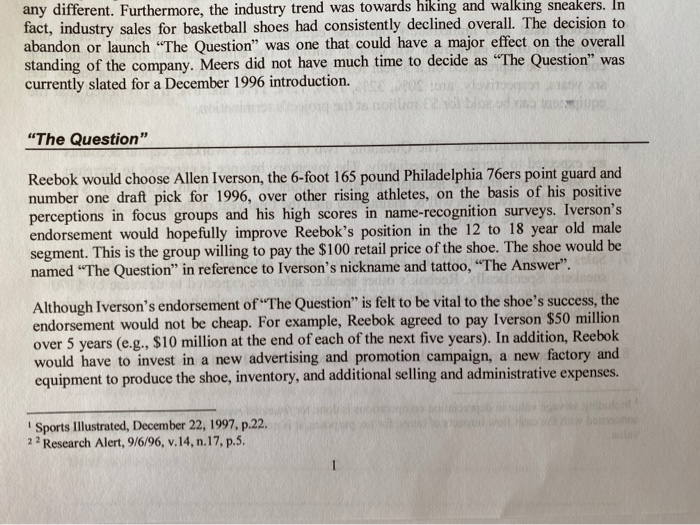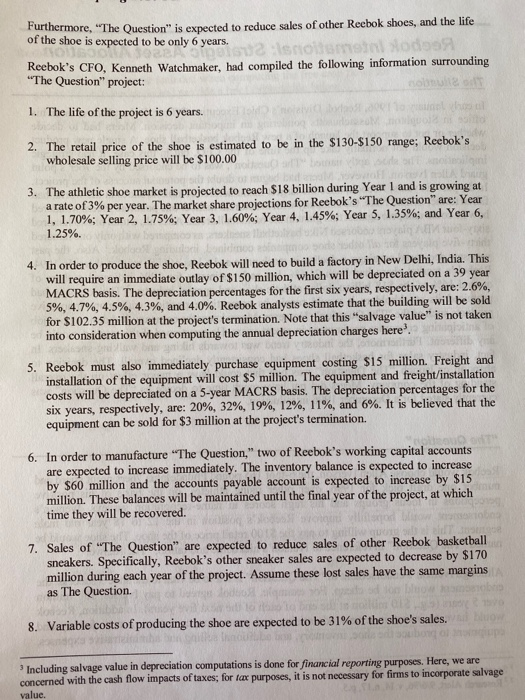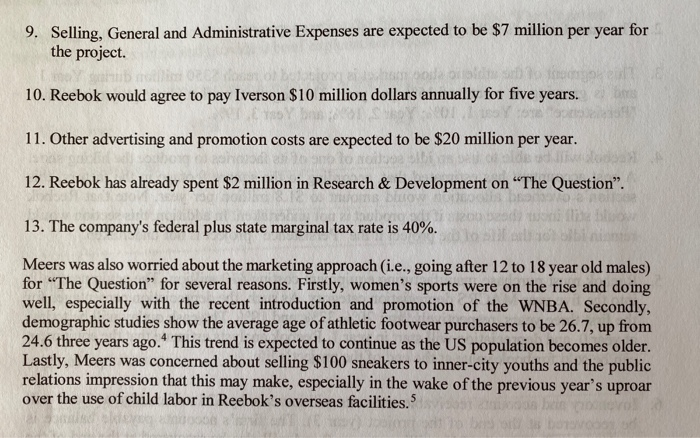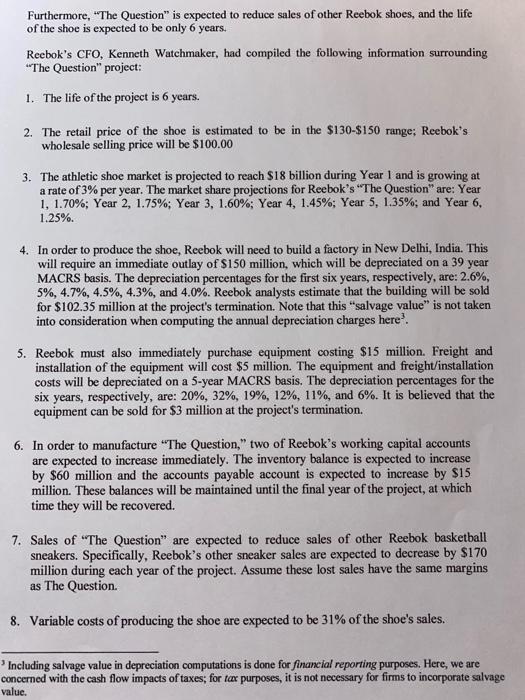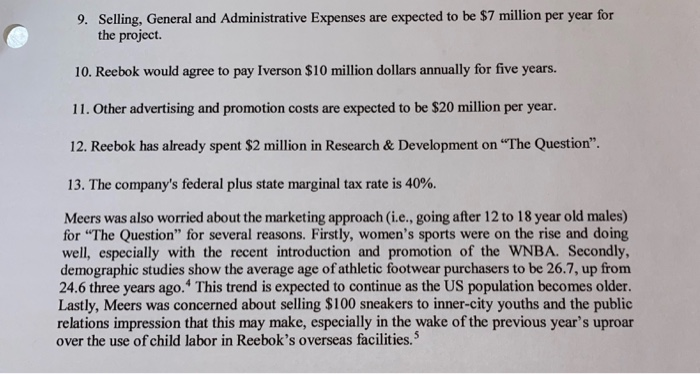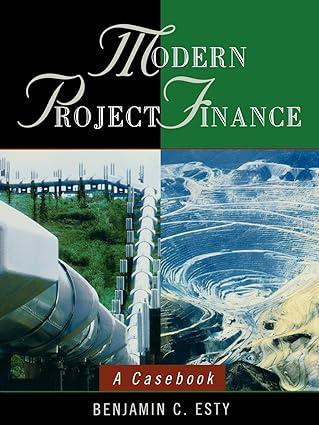1. Should the following be included when computing the free cash flows for "The Question" project? Circle yes or no and provide a brief explanation below.
-Building a factory and purchase/installation of the equipment.
-Research and Development costs.
-Cannibalization of the other Reebok sneaker sales.
-Changes in current asset/current liabilities accounts.
-Taxes
-Variable costs
-Advertising and promotion expenses
-Depreciation charges
any different. Furthermore, the industry trend was towards hiking and walking sneakers. In fact, industry sales for basketball shoes had consistently declined overall. The decision to abandon or launch The Question was one that could have a major effect on the overall standing of the company. Meers did not have much time to decide as "The Question" was currently slated for a December 1996 introduction. "The Question" Reebok would choose Allen Iverson, the 6-foot 165 pound Philadelphia 76ers point guard and number one draft pick for 1996, over other rising athletes, on the basis of his positive perceptions in focus groups and his high scores in name-recognition surveys. Iverson's endorsement would hopefully improve Reebok's position in the 12 to 18 year old male segment. This is the group willing to pay the $100 retail price of the shoe. The shoe would be named The Question" in reference to Iverson's nickname and tattoo, "The Answer". Although Iverson's endorsement of "The Question is felt to be vital to the shoe's success, the endorsement would not be cheap. For example, Reebok agreed to pay Iverson $50 million over 5 years (e.g., $10 million at the end of each of the next five years). In addition, Reebok would have to invest in a new advertising and promotion campaign, a new factory and equipment to produce the shoe, inventory, and additional selling and administrative expenses. Sports Illustrated, December 22, 1997, p.22. 2 ? Research Alert, 9/6/96, v.14, n.17, p.5. Furthermore, "The Question" is expected to reduce sales of other Reebok shoes, and the life of the shoe is expected to be only 6 years. Reebok's CFO, Kenneth Watchmaker, had compiled the following information surrounding "The Question project: 1. The life of the project is 6 years. 2. The retail price of the shoe is estimated to be in the $130-$150 range; Reebok's wholesale selling price will be $100.00 3. The athletic shoe market is projected to reach $18 billion during Year 1 and is growing at a rate of 3% per year. The market share projections for Reebok's "The Question" are: Year 1, 1.70%; Year 2, 1.75%; Year 3, 1.60%; Year 4. 1.45%; Year 5, 1.35%; and Year 6, 1.25%. 4. In order to produce the shoe, Reebok will need to build a factory in New Delhi, India. This will require an immediate outlay of $150 million, which will be depreciated on a 39 year MACRS basis. The depreciation percentages for the first six years, respectively, are: 2.6%, 5%, 4.7%, 4.5%, 4.3%, and 4.0%. Reebok analysts estimate that the building will be sold for $102.35 million at the project's termination. Note that this "salvage value is not taken into consideration when computing the annual depreciation charges here! Reebok must also immediately purchase equipment costing $15 million. Freight and installation of the equipment will cost $5 million. The equipment and freight/installation costs will be depreciated on a 5-year MACRS basis. The depreciation percentages for the six years, respectively, are: 20%, 32%, 19%, 12%, 11%, and 6%. It is believed that the equipment can be sold for $3 million at the project's termination. 6. In order to manufacture "The Question," two of Reebok's working capital accounts are expected to increase immediately. The inventory balance is expected to increase by $60 million and the accounts payable account is expected to increase by $15 million. These balances will be maintained until the final year of the project, at which time they will be recovered. 7. Sales of "The Question" are expected to reduce sales of other Reebok basketball sneakers. Specifically, Reebok's other sneaker sales are expected to decrease by $170 million during each year of the project. Assume these lost sales have the same margins as The Question 8. Variable costs of producing the shoe are expected to be 31% of the shoe's sales. Including salvage value in depreciation computations is done for financial reporting purposes. Here, we are concerned with the cash flow impacts of taxes; for fax purposes, it is not necessary for firms to incorporate salvage value. 9. Selling, General and Administrative Expenses are expected to be $7 million per year for the project. 10. Reebok would agree to pay Iverson $10 million dollars annually for five years. 11. Other advertising and promotion costs are expected to be $20 million per year. 12. Reebok has already spent $2 million in Research & Development on "The Question". 1200 13. The company's federal plus state marginal tax rate is 40%. Meers was also worried about the marketing approach (i.e., going after 12 to 18 year old males) for "The Question for several reasons. Firstly, women's sports were on the rise and doing well, especially with the recent introduction and promotion of the WNBA. Secondly, demographic studies show the average age of athletic footwear purchasers to be 26.7, up from 24.6 three years ago. This trend is expected to continue as the US population becomes older. Lastly, Meers was concerned about selling $100 sneakers to inner-city youths and the public relations impression that this may make, especially in the wake of the previous year's uproar over the use of child labor in Reebok's overseas facilities. Reebok International: Strategic Asset Allocation In early January of 1996, Reebok Division's Chief Executive Officer, Robert Meers, sat in his office in Stoughton, Massachusetts pondering an important decision. Meers had to decide whether or not to support the launch of a new Reebok basketball shoe. A single new product decision would not normally take up the time of the CEO, but in this case, it had strategic implications. The shoe, aptly named "The Question", was to be endorsed by the 76er's point guard Allen Iverson. However, Meers had begun to doubt the potential success of the project. In the past six years, Reebok, once the largest manufacturer of athletic shoes in the world, had fallen further behind Nike, the company with the current number one position. Meers wondered how he could compete against this giant in the basketball arena. After all, a total of two hundred sixty-four NBA players endorsed Nike basketball sneakers, as compared with only one hundred thirty-five players for all other shoe companies combined, including Reebok. Also, the past year saw decreased earnings, a decline in stock price and a loss of U.S. market share. In 1994, Reebok's market share had been 21.6%, but early estimates for 1996 indicated a share of around 16% of the S18 billion dollar athletic shoe and apparel industry. The company had promised its stockholders it would regain its competitive position with more innovative products such as the "The Question". However, Meers knew the company had done a poor job of anticipating consumer preferences in recent years. He questioned if this project would be any different. Furthermore, the industry trend was towards hiking and walking sneakers. In fact, industry sales for basketball shoes had consistently declined overall. The decision to abandon or launch "The Question" was one that could have a major effect on the overall standing of the company. Meers did not have much time to decide as "The Question" was currently slated for a December 1996 introduction. "The Question" number one draft pick for 1996, over other rising athletes, on the basis of his positive perceptions in focus groups and his high scores in name-recognition surveys. Iverson's endorsement would hopefully improve Reebok's position in the 12 to 18 year old male segment. This is the group willing to pay the $100 retail price of the shoe. The shoe would be named The Question" in reference to Iverson's nickname and tattoo, "The Answer". Although Iverson's endorsement of "The Question is felt to be vital to the shoe's success, the endorsement would not be cheap. For example, Reebok agreed to pay Iverson $50 million over 5 years (e.g., $10 million at the end of each of the next five years). In addition, Reebok would have to invest in a new advertising and promotion campaign, a new factory and equipment to produce the shoe, inventory, and additional selling and administrative expenses. Sports Illustrated, December 22, 1997, p.22. 2* Research Alert, 9/6/96, v.14, n.17. p.5. Furthermore, "The Question" is expected to reduce sales of other Reebok shoes, and the life of the shoe is expected to be only 6 years. Reebok's CFO, Kenneth Watchmaker, had compiled the following information surrounding "The Question project: 1. The life of the project is 6 years. 2. The retail price of the shoe is estimated to be in the $130-$150 range: Reebok's wholesale selling price will be $100.00 3. The athletic shoe market is projected to reach $18 billion during Year 1 and is growing at a rate of 3% per year. The market share projections for Reebok's "The Question" are: Year 1, 1.70%; Year 2, 1.75%; Year 3, 1.60%; Year 4, 1.45%; Year 5, 1.35%; and Year 6, 1.25%. 4. In order to produce the shoe, Reebok will need to build a factory in New Delhi, India. This will require an immediate outlay of $150 million, which will be depreciated on a 39 year MACRS basis. The depreciation percentages for the first six years, respectively, are: 2.6%, 5%, 4.7%, 4.5%, 4.3%, and 4.0%. Reebok analysts estimate that the building will be sold for $102.35 million at the project's termination. Note that this "salvage value" is not taken into consideration when computing the annual depreciation charges here'. 5. Reebok must also immediately purchase equipment costing $15 million. Freight and installation of the equipment will cost $5 million. The equipment and freight/installation costs will be depreciated on a 5-year MACRS basis. The depreciation percentages for the six years, respectively, are: 20%, 32%, 19%, 12%, 11%, and 6%. It is believed that the equipment can be sold for $3 million at the project's termination, 6. In order to manufacture "The Question," two of Reebok's working capital accounts are expected to increase immediately. The inventory balance is expected to increase by $60 million and the accounts payable account is expected to increase by $15 million. These balances will be maintained until the final year of the project, at which time they will be recovered. 7. Sales of "The Question" are expected to reduce sales of other Reebok basketball sneakers. Specifically, Reebok's other sneaker sales are expected to decrease by $170 million during each year of the project. Assume these lost sales have the same margins as The Question. 8. Variable costs of producing the shoe are expected to be 31% of the show's sales. Including salvage value in depreciation computations is done for financial reporting purposes. Here, we are concerned with the cash flow impacts of taxes; for for purposes, it is not necessary for firms to incorporate salvage value. the project 10. Reebok would agree to pay Iverson $10 million dollars annually for five years. 11. Other advertising and promotion costs are expected to be $20 million per year. 13. The company's federal plus state marginal tax rate is 40%. Meers was also worried about the marketing approach (i.e., going after 12 to 18 year old males) for "The Question" for several reasons. Firstly, women's sports were on the rise and doing well, especially with the recent introduction and promotion of the WNBA. Secondly, demographic studies show the average age of athletic footwear purchasers to be 26.7, up from 24.6 three years ago. This trend is expected to continue as the US population becomes older. Lastly, Meers was concerned about selling $100 sneakers to inner-city youths and the public relations impression that this may make, especially in the wake of the previous year's uproar over the use of child labor in Reebok's overseas facilities
